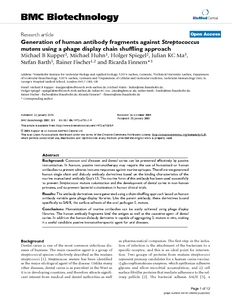Kuepper, MB; Huhn, M; Spiegel, H; Ma, JK; Barth, S; Fischer, R; Finnern, R
(2005)
Generation of human antibody fragments against Streptococcus mutans using a phage display chain shuffling approach.
BMC BIOTECHNOLOGY, 5 (4).
ISSN 1472-6750
https://doi.org/10.1186/1472-6750-5-4
SGUL Authors: Ma, Julian
![[img]](https://openaccess.sgul.ac.uk/107202/1.hassmallThumbnailVersion/Generation%20of%20human%20antibody.pdf)  Preview |
|
["document_typename_cannot open `/data/SGUL/sgul/eprints3/archives/sgul/documents/disk0/00/10/72/02/01/Generation' (No such file or directory)
cannot open `of' (No such file or directory)
cannot open `human' (No such file or directory)
cannot open `antibody.pdf' (No such fil" not defined]
Published Version
Download (4MB)
| Preview
|
Abstract
BACKGROUND: Common oral diseases and dental caries can be prevented effectively by passive immunization. In humans, passive immunotherapy may require the use of humanized or human antibodies to prevent adverse immune responses against murine epitopes. Therefore we generated human single chain and diabody antibody derivatives based on the binding characteristics of the murine monoclonal antibody Guy's 13. The murine form of this antibody has been used successfully to prevent Streptococcus mutans colonization and the development of dental caries in non-human primates, and to prevent bacterial colonization in human clinical trials.
RESULTS: The antibody derivatives were generated using a chain-shuffling approach based on human antibody variable gene phage-display libraries. Like the parent antibody, these derivatives bound specifically to SAI/II, the surface adhesin of the oral pathogen S. mutans.
CONCLUSIONS: Humanization of murine antibodies can be easily achieved using phage display libraries. The human antibody fragments bind the antigen as well as the causative agent of dental caries. In addition the human diabody derivative is capable of aggregating S. mutans in vitro, making it a useful candidate passive immunotherapeutic agent for oral diseases.
| Item Type: |
Article
|
| Additional Information: |
© 2005 Kupper et al; licensee BioMed Central Ltd.
This is an Open Access article distributed under the terms of the Creative Commons Attribution License (http://creativecommons.org/licenses/by/2.0), which permits unrestricted use, distribution, and reproduction in any medium, provided the original work is properly cited. |
| Keywords: |
Science & Technology, Life Sciences & Biomedicine, Biotechnology & Applied Microbiology, BIOTECHNOLOGY & APPLIED MICROBIOLOGY, LOCAL PASSIVE-IMMUNIZATION, MONOCLONAL-ANTIBODIES, DENTAL-CARIES, SURFACE, EXPRESSION, LIBRARIES, PROTEINS, ANTIGEN |
| SGUL Research Institute / Research Centre: |
Academic Structure > Infection and Immunity Research Institute (INII) |
| Journal or Publication Title: |
BMC BIOTECHNOLOGY |
| ISSN: |
1472-6750 |
| Dates: |
| Date | Event |
|---|
| 25 January 2005 | Published |
|
| URI: |
https://openaccess.sgul.ac.uk/id/eprint/107202 |
| Publisher's version: |
https://doi.org/10.1186/1472-6750-5-4 |
Statistics
Item downloaded times since 30 Jan 2015.
Actions (login required)
 |
Edit Item |


